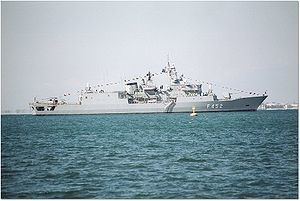Name Hydra Commissioned 1992 Length 117 m Displacement 3.039 million kg Builder Blohm + Voss | Namesake the Hydra Island Fate in active service Launched 25 June 1991 Weight 3,404 tons Draft 6 m | |
 | ||
Notes Official Hellenic Navy page | ||
Greek frigate hydra f 452 top 6 facts
Hydra (F-452) (Greek Φ/Γ Ύδρα) is the lead ship of the Greek Hydra-class frigate and flagship of the Hellenic Navy. The ship was built in the same shipyard as the Blohm + Voss MEKO 200 frigate class, on which its design was based. Three more vessels were built by Hellenic Shipyards Co. at Skaramagas in following years. It is the fifth ship in the Hellenic Navy to bear the name Hydra.
Contents
Hydra was the first of four frigates of the MEKO 200 type (the four being Hydra, Spetsai, Psara, and Salamis) ordered by the Greek government. The ship was delivered to the Hellenic Navy on 15 October 1992 and first sailed in Greek waters on 28 January 1993. The crest of the frigate Hydra is the same as that of her predecessor. It is based on one of the flags which the ships of Hydra sailed under during the 1821 revolution.
In April 1988, the Hellenic Navy proposed and approved the four frigates of the MEKO 200 type in an effort to modernize its fleet. After a lengthy negotiation process, the following contracts were signed to fulfill the program:
History of the name
The ship's name comes from the island of Hydra, whose fleet participated in the war of national independence in 1811. Along with the fleets of the Greek islands of Spectate and Para, Hydra's fleet succeeded in taking control of the Aegean Sea and prevented the Ottoman Empire from successfully deploying its fleet.
